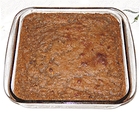|
Caribbean Side Sweet Potato Pudding A sweet, nutty dish of mashed sweet potatoes—it's popular in the Caribbeans as both a vegetable side dish and a dessert.
Pecans: in a hot non-stick skillet, toast (or brown) the chopped pecans. Shake the pan gently so as not to burn the nuts. You'll know they're done when the let off their nutty fragrance. Set aside. Yams: preheat oven to 350 F. Bbake the yams/sweet potatoes 1 hour or till you can poke them through easily with a fork. Don't turn off the oven. Bake: Turn pudding mixture into a good-sized, well-greased casserole dish and bake for 50-60 minutes. |
Tips & Glossary Caribbean cuisine is an exquisite blend of African, Asian, European, and Carib Indian (the area's original inhabitants) foods. Dishes are highly seasoned, either with a dry rub or marinade —or both. Below are some typical ingredients found in Caribbean food. Callaloo: young leaves of either the taro root plant or amaranth used widely in Caribbean cooking. Spinach can be used as a substitute. Spices: Allspice, bay leaves, black pepper, chives, chili peppers, cilantro, cinnamon, coconut, curry powder, escallion, garlic, ginger, lime, mace, nutmeg, onion, oregano, sugar, thyme, orange, tomato paste, vanilla, cayenne (red) pepper. Jerk: Jamaican cooking method in which meat is rubbed, prior to grilling, with a blend of seasonings, often firey hot. • 1 T each—onion powder, garlic powder, dried chives, brown sugar; 2 tsp. each— (ground) allspice, nutmeg, cinnamon; 1 tsp. each—sage. thyme, salt, black pepper, cayenne (or more to taste). Mix thoroughly and store in a tightly covered jar. There are thousands of versions; figure out what flavors you like most and add or subtract accordingly. Typical meats: goat, pork, chicken, and some beef (though beef has tended to be expensive). Fish: varieties that abound in surrounding waters, some familiar to us—grouper, cod, tilapia, blue marlin; others not so—200 species of jack, chip-chips (tiny clams), casadura (primitive armored catfish). Native plant foods: More familiar foods:
|
Site by BOOM
![]()
LitLovers © 2024

